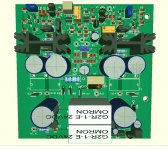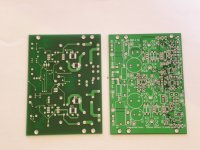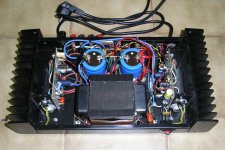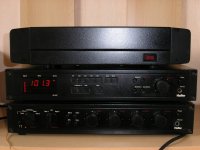Andrew,
A common issue in the Hafler power amps is the failure of the AC power switch.
Most current rebuilds of the amps replaces/increases the original DC filter caps (currently using 39,000 uf in the same capacitor case size). This further increases the stress on the AC switch at turn on which a thermistor reduces sufficently to improve switch reliability (in the 20 years since I started adding the thermistors not one AC switch has failed in about 60 ampfliers modified). While the 4 early Krell amps i have in house at the moment all have relay bypassed soft start resistors which I prefer there isn't room in the Hafler chassis without mechanical repositioning of existing components which isn't time /cost effective.
While your comments are interesting, the reality of long term field use says the thermistors work.
A common issue in the Hafler power amps is the failure of the AC power switch.
Most current rebuilds of the amps replaces/increases the original DC filter caps (currently using 39,000 uf in the same capacitor case size). This further increases the stress on the AC switch at turn on which a thermistor reduces sufficently to improve switch reliability (in the 20 years since I started adding the thermistors not one AC switch has failed in about 60 ampfliers modified). While the 4 early Krell amps i have in house at the moment all have relay bypassed soft start resistors which I prefer there isn't room in the Hafler chassis without mechanical repositioning of existing components which isn't time /cost effective.
While your comments are interesting, the reality of long term field use says the thermistors work.
switch ON is not a stressfull duty for a mains switch.
If the Hafler switch has a reputation for poor reliability, then it is far more likely that it is the switch OFF condition that is damaging the switch contacts.
Unless the amp is simply pulling too much current for the rating of the contacts and the wires/strips leading to the contacts. Check what rating is on the switch.
If the Hafler switch has a reputation for poor reliability, then it is far more likely that it is the switch OFF condition that is damaging the switch contacts.
Unless the amp is simply pulling too much current for the rating of the contacts and the wires/strips leading to the contacts. Check what rating is on the switch.
and I agree. A Power Thermistor works very well as the current limiting device for soft starting.............. the reality of long term field use says the thermistors work.
Last edited:
When these pcb's will be available?
Buna ziua felixx,
thanks for your interest. You have send 2 questions in one.
Availability: I dont know, if i sell this pcb right now
When: i Just ordered the PCB in China, and will receive them in 3 weeks, then i have to look for all components and test the first boards. This is still in prototype status
I'll keep you informed
BR
Guenther
Awhile back Chris, I tried replacing the power switch with a Solid State switch (Zero X relay type) for a large power amp and after sorting out the problems of transformer load and turn-off, functioned perfectly - not a cheap substitution tho and didn't bother again - simple switch 'done right' seems pretty okay with the thermistor, MOV, maybe line filter, dc trap, etc, etc ...
Hi James,
Yes, I also understand the frustration of having to us a solid state relay as well. In my case it was to replace a non-standard switch that was NLA. The soft-start coupled with an MOV across the transformer primary takes a lot of the beating off a switch (or relay). I didn't bother with the zero switching variant as the original switch wasn't timed either. The difference in cost really pushed the zero switching one out of the picture. DC isolator isn't as useful, but then I rarely use a toroid transformer.
Aside from the cost on yours, how did it turn out?
-Chris
Yes, I also understand the frustration of having to us a solid state relay as well. In my case it was to replace a non-standard switch that was NLA. The soft-start coupled with an MOV across the transformer primary takes a lot of the beating off a switch (or relay). I didn't bother with the zero switching variant as the original switch wasn't timed either. The difference in cost really pushed the zero switching one out of the picture. DC isolator isn't as useful, but then I rarely use a toroid transformer.
Aside from the cost on yours, how did it turn out?
-Chris
Well, it worked like a charm, once I managed to stop the devices blowing up! Transformer was an 800vA EI of 50V ac into 4 x 20,000uF rails, from memory used big Siemens + Rifa caps - 2 stage soft start - no limits for diy, eh!
The zero crossing was/is such a useful idea in power switching that I'm a bit surprised we don't see more of it in audio but from my point of view, we were using it primarily as a lighting control system and we got used to 'bad loads' like transformers - interrupting the current flow thru a transformer does generate some troublesome voltages that make it quite hard to turn off the triacs as the mains isn't always constant at all venues - makes diode switching look tame
The solid state relays that are cheaply available (china, india, mexico, etc) are generally not particularly useful for inductive loads but the commercial ones have sorted this out - they're not cheap at all and fitted with a lot of protective 'stuff' - at least the US and Germany ones that I've seen.
I think they use a zero crossing control chip these days if these haven't been replaced by a program + interface with active sensing - my adventures with the entertainment industry and PA systems was quite a few years ago now so have forgotten most of this - very interesting engineering tho.
The zero crossing was/is such a useful idea in power switching that I'm a bit surprised we don't see more of it in audio but from my point of view, we were using it primarily as a lighting control system and we got used to 'bad loads' like transformers - interrupting the current flow thru a transformer does generate some troublesome voltages that make it quite hard to turn off the triacs as the mains isn't always constant at all venues - makes diode switching look tame
The solid state relays that are cheaply available (china, india, mexico, etc) are generally not particularly useful for inductive loads but the commercial ones have sorted this out - they're not cheap at all and fitted with a lot of protective 'stuff' - at least the US and Germany ones that I've seen.
I think they use a zero crossing control chip these days if these haven't been replaced by a program + interface with active sensing - my adventures with the entertainment industry and PA systems was quite a few years ago now so have forgotten most of this - very interesting engineering tho.
I am aware that relay type contacts suffer the "bounce".Andrew,
Are you aware that switch contacts bounce when turned on? The turn on state is also hard on a switch. If you serviced amplifiers, you would notice that ones that use a soft start do not go through power switches even though there are no MOVs in use.
-Chris
I am not aware of that happening with a mains switch.
I am aware that relay type contacts suffer the "bounce".
I am not aware of that happening with a mains switch.
All switches bounce. With small ones you might not notice it but the contacts will bounce as they all have some kind of spring system to push the contacts with some force against each other. Switches for high currents (I work with 1000 to 3200 A ones) have a spring powered by an electric motor to reduce the bouncing which would otherwise burn the switch with only a few times switching. Also there are multiple hard silver contacts in parallel to have less resistance. To reduce arc flashing such switches have extinguishing chambers too. In case the electric motor does not work as there is no voltage at all then the spring can be loaded manually by swinging a large lever a few times. When switched they sound like a small hand grenade so ear protection is a must. Just some info.
I have seen some Sony amplifiers of the nineties that had remote control and a always-on PSU to power the remote control electronics. They could be manually operated with a very small power switch on the front. These switches bounced and thus the amp was difficult to switch on manually as it really switched on and off a few times per second (and stayed in the off position fully in compliance with Murphys Law
With low power electronics and small switches often Schmitt trigger circuits are employed to overcome the bouncing of contacts.
Last edited:
New draft of the DH-220C series
Hello,
this is my new draft of the Hafler DH-220 design, presented by Bob Cordell on Burning Amp Festival 2016. It is based on my DH-120C layout , but adapted to the physical size of the Hafler DH-200/220.
The DH-120C pcb is already in prototype production. Now it's time to get all components and debug the PCB design. with the experience from this work, i hopefully can finish also the other two designs, i already published in this thread.
Due to leftover space, i also realised a speaker protection on the new design.
BR
Guenther
Hello,
this is my new draft of the Hafler DH-220 design, presented by Bob Cordell on Burning Amp Festival 2016. It is based on my DH-120C layout , but adapted to the physical size of the Hafler DH-200/220.
The DH-120C pcb is already in prototype production. Now it's time to get all components and debug the PCB design. with the experience from this work, i hopefully can finish also the other two designs, i already published in this thread.
Due to leftover space, i also realised a speaker protection on the new design.
BR
Guenther
Attachments
First prototype PCBs of DH-120C arrived
Hello,
today arrived the first prototype PCBs for my DH-120C, Bob Cordell's design of the DH-220C adapted to the DH-120. Now is's getting interesting, time to populate and test the boards.
One problem remains, i am still looking for someone in the US to order for me the LSK489 and the LSJ 689 (5 of each) at Trendsetter.com and send it as letter to me to Germany. Trendsetter asks for $ 35 only for shipment and the local distributor ask for more than double the price. So somebody out there to help me, every support is welcome
Best regards
Guenther
Hello,
today arrived the first prototype PCBs for my DH-120C, Bob Cordell's design of the DH-220C adapted to the DH-120. Now is's getting interesting, time to populate and test the boards.
One problem remains, i am still looking for someone in the US to order for me the LSK489 and the LSJ 689 (5 of each) at Trendsetter.com and send it as letter to me to Germany. Trendsetter asks for $ 35 only for shipment and the local distributor ask for more than double the price. So somebody out there to help me, every support is welcome
Best regards
Guenther
Attachments
Looks good.
I do not think that it would be any cheaper for me in Canada. $35 for shipping to Germany is not that bad. It is a long way to go.
I went to the trendsetter web site and searched for lsj689, lsk489 they show stocking of lsj689 in sot-23-6,TO-71 and lsk489 in sot23-6,soic-8,TO-71. Looking at your pcb it looks like you used the soic-8 package for both devices.
You should confirm exactly what package type(s) that you require.
Where are you getting the rest of the parts from?
When I look at your post #1392 is see you had relays which I assume are for speaker protection and circuitry. Why did you not include it on the pcb that you designed. Instead I see fuses now? Why fuses, I hope that they are not used for speaker protection now instead of relays. It is is known that fuses add distortion to the signal, esp if they are not in the feedback loop.
I do not think that it would be any cheaper for me in Canada. $35 for shipping to Germany is not that bad. It is a long way to go.
I went to the trendsetter web site and searched for lsj689, lsk489 they show stocking of lsj689 in sot-23-6,TO-71 and lsk489 in sot23-6,soic-8,TO-71. Looking at your pcb it looks like you used the soic-8 package for both devices.
You should confirm exactly what package type(s) that you require.
Where are you getting the rest of the parts from?
When I look at your post #1392 is see you had relays which I assume are for speaker protection and circuitry. Why did you not include it on the pcb that you designed. Instead I see fuses now? Why fuses, I hope that they are not used for speaker protection now instead of relays. It is is known that fuses add distortion to the signal, esp if they are not in the feedback loop.
Last edited:
Hello,
today arrived the first prototype PCBs for my DH-120C, Bob Cordell's design of the DH-220C adapted to the DH-120. Now is's getting interesting, time to populate and test the boards.
One problem remains, i am still looking for someone in the US to order for me the LSK489 and the LSJ 689 (5 of each) at Trendsetter.com and send it as letter to me to Germany. Trendsetter asks for $ 35 only for shipment and the local distributor ask for more than double the price. So somebody out there to help me, every support is welcome
Best regards
Guenther
Contact Paul Norton at Linear Systems and tell him that I steered you to him, and tell him that you are building a version of my DH220C design, whic Paul is very familiar with. He might be willing to sample you.
Cheers,
Bob
Looks good.
I do not think that it would be any cheaper for me in Canada. $35 for shipping to Germany is not that bad. It is a long way to go.
I went to the trendsetter web site and searched for lsj689, lsk489 they show stocking of lsj689 in sot-23-6,TO-71 and lsk489 in sot23-6,soic-8,TO-71. Looking at your pcb it looks like you used the soic-8 package for both devices.
You should confirm exactly what package type(s) that you require.
Where are you getting the rest of the parts from?
When I look at your post #1392 is see you had relays which I assume are for speaker protection and circuitry. Why did you not include it on the pcb that you designed. Instead I see fuses now? Why fuses, I hope that they are not used for speaker protection now instead of relays. It is is known that fuses add distortion to the signal, esp if they are not in the feedback loop.
Hello rsavas,
At the last time i checked trendsetter had LSJ689 in SO-8 case in stock, maybe have to wait, when again available.
The rest of the parts like minimelfs (diode and resistors) the MMBT5551/5401, 2N5551/5401 BD140, OPA2134 and the KSA1381E/KSC3503E are already there.
The board from post #1392 is a board for the DH-220/200 which is about 111mmx111mm. the actual board only measures only 108mm x 75 mm for the DH-120.
The fuses are the rail fuses according to the original design of the PC-25 boards from Hafler. The speaker protection didn't find place on the PCB and is done by an external board. Attached you will see the new home of the PCBs
BR
Gunni
Attachments
Very interesting! are you making new PCBs for the 220 too???
My schedule is, first make the DH-120C boards work. Based on that, i wanna rebuild a board based on the DH-220C with integrated powerstage (2x2SK1058/2x2SJ162). And finally a board as replacement for the existing PC-19 (PC-6) board of the Hafler DH-220/200. So i think a long way to go.
BR
Gunni
- Home
- Amplifiers
- Solid State
- Hafler DH-200/220 Mods



